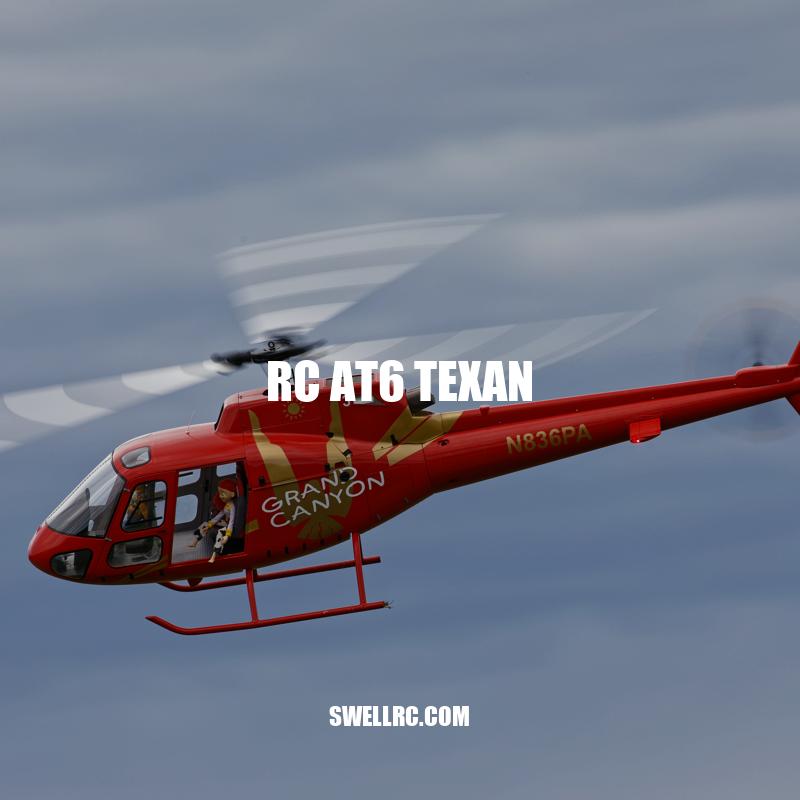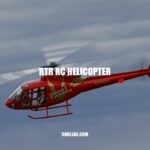RC AT-6 Texan: Scale Replica of a Legendary Training Aircraft
The AT-6 Texan is a beloved aircraft that is steeped in history. Originally introduced in the late 1930s as an advanced trainer aircraft, it quickly became popular with pilots and air forces around the world. During World War II, the AT-6 Texan was used extensively as both a trainer and a light attack aircraft. After the war, it continued to be used by many air forces as a training aircraft, with some remaining in service until the 1970s. Today, the AT-6 Texan is still a beloved aircraft that is revered by aviation enthusiasts. The RC AT-6 Texan is a radio-controlled model of this iconic aircraft that offers an accurate and realistic flying experience for enthusiasts who love this particular type of plane. It is typically made from balsa wood and is powered by a small gasoline engine. The RC AT-6 Texan has a wingspan of around six feet and can reach speeds of up to 50 mph, making it a great choice for those who enjoy radio-controlled flight. In this article, we’ll take a closer look at the history of the AT-6 Texan, the design and features of the RC AT-6 Texan, and what it’s like to fly this popular radio-controlled aircraft.
History of the AT-6 Texan
The AT-6 Texan has a rich history that spans several decades and has left an indelible mark on aviation history. Here are some key facts and milestones:
- The AT-6 Texan was designed in the late 1930s by North American Aviation as an advanced trainer aircraft
- It was originally named the North American NA-16 and was later redesignated as the AT-6 Texan
- During World War II, the AT-6 Texan was used by the United States Army Air Forces as both a trainer and a light attack aircraft
- It was also used as a primary trainer by several other countries, including Canada, Brazil, and the United Kingdom
- After the war, the AT-6 Texan continued to be used as a training aircraft by many air forces around the world, with some remaining in service until the 1970s
- The AT-6 Texan is also known by several nicknames, including the “SNJ” (used by the US Navy), the “Harvard” (used by Canada and other Commonwealth countries), and the “Jungle Skipper” (used by the Philippine Air Force)
If you’re interested in learning more about the history of the AT-6 Texan, there are several websites and books that offer in-depth information and resources. For example, the Commemorative Air Force Museum has a dedicated exhibit on the AT-6 Texan, and the North American Trainer Association is a great resource for enthusiasts and pilots who are interested in this iconic aircraft. Additionally, books such as “The North American T-6: A Definitive History” by Dan Hagedorn offer a thorough look at the history and development of the AT-6 Texan.
How many T-6 Texans are still flying?
According to the information available, it is estimated that around 1,200-1,300 T-6 Texans are still flying worldwide. However, this number is subject to change due to ongoing restorations and retirements. Specific information on the current number of T-6 Texans flying may be available on aviation enthusiast forums or websites such as WarbirdRegistry.org or FlyRadius.com.
Design and Features of the RC AT-6 Texan
The RC AT-6 Texan is designed to be an accurate and realistic scale replica of the original AT-6 Texan, with many of the same design features and characteristics. Here are some of the key design elements and specifications of the aircraft:
| Specs | RC AT-6 Texan |
|---|---|
| Wingspan | Approximately 6 feet |
| Length | Approximately 4 feet |
| Powerplant | Gasoline engine |
| Maximum Speed | Approximately 50 mph |
| Realistic features | Flaps, landing gear, detailed cockpit |
Other design elements and features of the RC AT-6 Texan include:
- The aircraft is typically made from balsa wood, which makes it lightweight and durable
- Many RC Texan kits come with pre-cut pieces that can be easily assembled with basic tools and adhesives
- The aircraft typically features a two-channel remote control system, which allows for basic flight control
- Some more advanced models come with additional features, such as retractable landing gear and four-channel control systems for greater maneuverability
- The RC AT-6 Texan is designed to look and fly like the original aircraft, so enthusiasts can experience the thrill of flying a vintage military plane without the expense or hassle of owning a full-scale replica
If you’re interested in purchasing an RC AT-6 Texan model, there are several websites and retailers that specialize in radio-controlled aircraft. HobbyKing and Motion RC are two popular online retailers that offer a range of RC aircraft and accessories, including the RC AT-6 Texan. You can also visit your local hobby shop or attend a RC aircraft convention or show to see the latest models and talk to other enthusiasts.
What are the components of a remote control plane?
The components of a remote control plane typically include:
- Radio transmitter
- Receiver
- Servos
- Battery
- Motor
- Propeller
- Wings
- Fuselage
- Landing gear
Different models of remote control planes may have additional components or variations in the components listed above.
For more detailed information on remote control planes and their components, websites such as https://www.flitetest.com/ and products such as the HobbyZone Sport Cub S RC Airplane can be consulted.
Flying the RC AT-6 Texan
The RC AT-6 Texan is a popular aircraft for radio-controlled flying enthusiasts of all skill levels. Whether you’re a beginner or an experienced pilot, here are some things to keep in mind when flying the RC AT-6 Texan:
- The aircraft is relatively easy to fly, making it a good choice for beginners who are just starting out with RC planes
- However, it’s important to have some basic knowledge of radio-controlled flying and to practice in an open and safe area, away from buildings, trees, and other obstacles
- The RC Texan is capable of performing a variety of aerobatic maneuvers, including loops, rolls, and inverted flight. However, these maneuvers should only be attempted by experienced pilots who are familiar with the aircraft’s capabilities
- The RC AT-6 Texan typically has a flight time of around 10 to 15 minutes, depending on the power source and flying conditions. It’s important to monitor the battery level and to land the aircraft before the battery runs out of power
- The aircraft is typically equipped with a two-channel remote control system, which allows for basic control of the aircraft’s throttle and direction. Some more advanced models may have four-channel control systems, which offer greater maneuverability and control
- If you’re new to radio-controlled flying, it’s a good idea to practice with a smaller and less complex aircraft before moving up to the RC AT-6 Texan. This will give you a chance to develop your skills and gain confidence before tackling a more advanced model
Overall, the RC AT-6 Texan is a fun and exciting aircraft for radio-controlled flying enthusiasts who enjoy vintage military planes. If you’re interested in purchasing an RC AT-6 Texan model, be sure to do your research and find a high-quality kit from a reputable manufacturer or retailer. Websites such as Amazon, Horizon Hobby, and Tower Hobbies offer a wide selection of RC planes, as well as accessories and replacement parts.
What was the first radio controlled airplane?
The first radio-controlled airplane was developed in the mid-1930s by members of the Royal Aircraft Establishment in the UK and was called the Larynx. It was initially developed for military purposes and was used for target practice. The Larynx had a wingspan of 6 meters and used a pre-programmed mechanical autopilot for control. Since then, radio-controlled airplanes have become immensely popular as a hobby for enthusiasts worldwide. For more information on radio-controlled airplanes check out websites like HobbyKing, Horizon Hobby, and RC groups.
Purchasing an RC AT-6 Texan
If you’re ready to purchase an RC AT-6 Texan, there are several factors to consider. Here are some tips to help you make an informed decision:
- Determine your budget for the aircraft. The price of an RC AT-6 Texan can vary depending on the quality of the kit and the level of detail included.
- Decide whether you want to purchase a ready-to-fly (RTF) kit, an almost-ready-to-fly (ARF) kit, or a build-from-scratch kit. An RTF kit comes pre-assembled and ready to fly, while an ARF kit requires some basic assembly but does not include all of the necessary components (such as the radio system and engine). A build-from-scratch kit requires the most time and effort but allows for the greatest level of customization.
- Research the manufacturer and read reviews from other customers to ensure that you are getting a high-quality aircraft that meets your needs. Websites such as Amazon, Horizon Hobby, and Tower Hobbies offer a wide selection of RC planes, including the RC AT-6 Texan, and can be a great resource for researching different manufacturers and kits.
- Don’t forget to factor in the cost of additional equipment, such as the radio control system, engine, and batteries.
- If you’re new to radio-controlled flying, consider purchasing a simulator software program or using a simulator at a local hobby shop before purchasing the actual kit.
- Websites such as Amazon, Horizon Hobby, and Tower Hobbies offer a wide selection of RC planes, including the RC AT-6 Texan. These websites also offer accessories and replacement parts, which can be useful in case of damage or wear and tear.
By keeping these factors in mind, you can make an informed decision when purchasing an RC AT-6 Texan that meets your needs and fits within your budget.
What is almost ready to fly?
Almost Ready to Fly (ARF) is a term used in the remote-controlled aircraft hobby to describe an aircraft that requires minimal assembly before it is ready to fly. This means the model comes with most of the necessary components pre-built, such as the airframe, wings, and tail, but may still require some final assembly or installation of electronics, such as a motor, servos, and radio equipment.
Some websites that specialize in selling ARF models include:
| Website | Products |
|---|---|
| Horizon Hobby |
|
| Hobbyking |
|
| Tower Hobbies |
|
Conclusion
The RC AT-6 Texan is a beloved aircraft that has a rich history and continues to be a popular choice for radio-controlled flying enthusiasts. Its realistic design and fun flying experience make it a great addition to any collection, whether you’re a beginner or an experienced pilot. If you’re looking to purchase an RC AT-6 Texan, it’s important to consider your budget, level of experience, and personal preferences before making a decision. By doing your research and evaluating your options, you can find a high-quality aircraft that meets your needs and provides hours of flying enjoyment. Whether you’re flying solo or with friends, the RC AT-6 Texan is sure to turn heads and provide an exhilarating experience. So get ready for takeoff and experience the thrills of radio-controlled flying with the RC AT-6 Texan!



